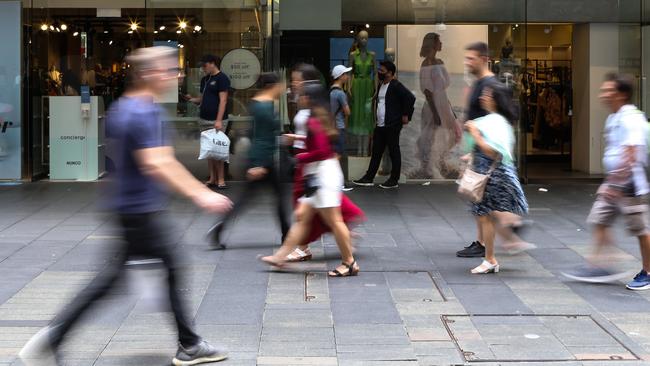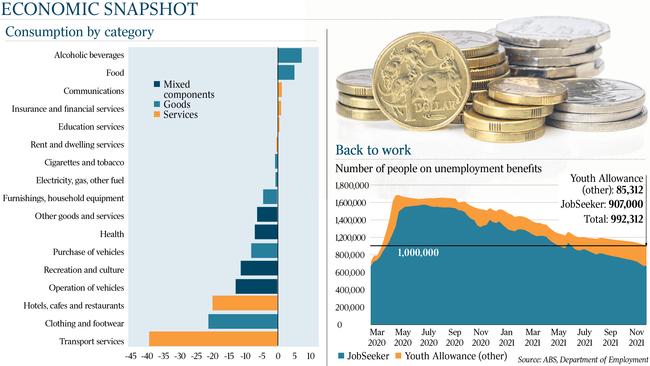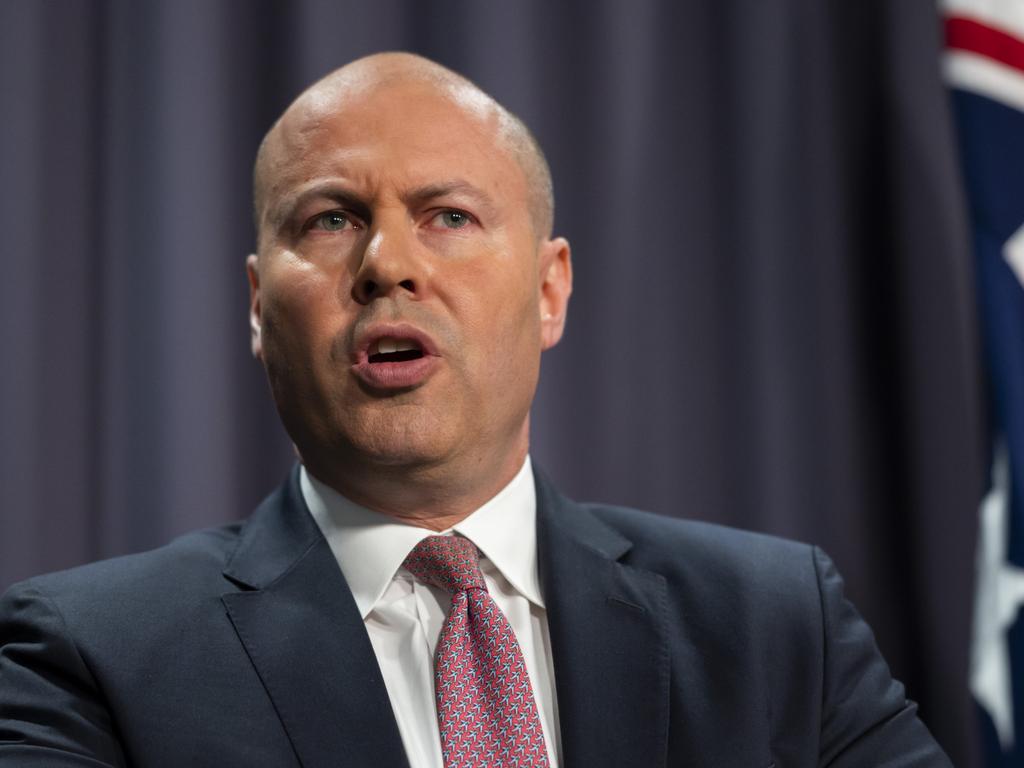GDP figures show economy contracts 1.9 per cent under Delta blow
The economy is on track for a return to pre-pandemic levels by May, with the government predicting growth of more than 1.5 per cent in the final three months of the year

Australia’s resurgent economy is on track for a return to pre-pandemic levels by May, with the government predicting growth of more than 1.5 per cent in the final three months of the year fuelled by Christmas shopping sprees, surges in domestic travel and people returning to work.
National accounts figures released on Wednesday revealed the economy performed better than Treasury and economists had feared over the September quarter, suffering a 1.9 per cent slump in GDP following Delta outbreaks and lockdowns.
Josh Frydenberg, who will announce a stronger budget position in the mid-year economic and fiscal outlook on December 16, said that while the retraction was a reminder of the “heavy economic costs of lockdown”, there was good news in that “lockdowns are behind us”.
Despite caution over the Omicron variant of Covid-19 and a temporary pause on allowing more than 200,000 visa holders into the country, Treasury officials were optimistic about a faster rebound in the December quarter compared with last year’s lockdown recovery.
Pointing to sharp rebounds in retail trade and jobs as health ¬restrictions lifted in NSW, Victoria and the ACT, the Treasurer said the economy was recovering strongly. “There will be challenges ahead, but with vaccination rates here in Australia having reason to be among the highest in the world, we can and we must live with the virus and its variants,” Mr Frydenberg said.
“Omicron is not the first, and is unlikely to be the last variant that we face. We must hold our nerve and cool heads must prevail.”
The Australian Bureau of Statistics national accounts data revealed the third largest quarterly contraction going back five decades, after output lifted by 0.7 per cent in the preceding period. The economy was 3.9 per cent larger than a year earlier, although the annual growth rate was flattered by a weak point of comparison.
The seasonally adjusted figures also revealed that the economy was now 0.2 per cent smaller compared with pre-pandemic levels in December 2019.
As business groups called on governments to avoid reimposing ¬restrictions in response to Omicron, Treasury predicted that most of the losses incurred during the Delta lockdowns would be recouped in the December quarter.
While the economy took longer to recover from last year’s Covid-19 recession, governments, businesses, households and workers had adapted better to “snapping back”.
If the threat of Omicron passes quickly, there was likely to be minimal impact on economic growth as Australians returned in droves to shopping centres, restaurants and domestic travel.
Despite the December quarter overlapping with Delta lockdowns, the best-case scenario is for economic growth to return to more than 1.5 per cent in the final three months of the year.

A strengthening labour market coupled with people coming off Covid-19 disaster payments and returning to work has driven confidence and spending in the lead-up to Christmas.
The national accounts showed NSW bore the brunt of the fourth Covid-19 wave of infections with its economy, as measured by state final demand, plunging by 6.5 per cent. The Victorian and ACT economies proved surprisingly resilient, recording more moderate declines of about 1.5 per cent.
All other states and territories expanded through the quarter.
As Mr Frydenberg declared that driving down the unemployment rate would be crucial to repairing the budget, The Australian can reveal the number of people relying on dole payments has fallen to its lowest level since the pandemic struck last year.
As of last Friday, Department of Social Services data showed 988,391 Australians were receiving JobSeeker and Youth Allowance payments, down from a peak of 1,649,794 in May last year.
In a good indicator for December quarter growth, the DSS data revealed welfare recipients in NSW and Victoria were moving back into work at a faster pace than other states.
Social Services Minister Anne Ruston said employers were “desperate for more workers” and jobless Australians should consider taking on seasonal work over summer.
“The number of Australians relying on the social security system has been reducing since the early months of the pandemic in 2020,” Senator Ruston said.
“However, there is often a seasonal increase in people accessing the social security system over the Christmas break.

“My message to all jobseekers is that it is clear employers are desperate for more workers, with job ads reaching record highs. Consider seasonal work outside your past experience or even take the opportunity to head to the regions over the summer.”
The decline in activity through the September quarter was milder than the 2.7 per cent contraction tipped by economists. With more than half of the population under stay-at-home orders for long stretches during the quarter, household consumption dropped 4.8 per cent. Household spending in NSW and the ACT fell by about 11 per cent, and by 5.2 per cent in Victoria. The ABS figures revealed household gross disposable income jumped by 4.6 per cent, the fastest rise since the December quarter of 2008.
“Government support payments to households and unincorporated businesses affected by Covid-19, along with increased dividend payments, contributed to the increase in household income,” the ABS said.
The combination of lockdowns and economic support helped lift the household savings rate from 11.8 to 19.8 per cent.
Deloitte Access Economics partner Chris Richardson said households added $40bn to their savings in the September quarter, “making it almost a quarter of a trillion dollars up on pre-pandemic”. Mr Richardson said the commonwealth budget position would likely track the May forecast for a $107bn deficit in this financial year.
A booming trade sector helped cushion the hit from lockdowns, adding 1 percentage point to real GDP growth amid a record current account surplus, while government spending contributed 0.8 percentage points to growth.

Opposition Treasury spokesman Jim Chalmers said Australia had fallen behind the world and ranked “dead last” out of 28 OECD countries during the September quarter. Dr Chalmers said the Delta outbreaks and lockdowns were avoidable, blaming the Coalition for “failures on vaccines, and quarantine and economic support which led to the economic carnage”.
“We’ve been very clear about our priorities in the budget: we need to grow the economy, we need to prioritise bang for buck, and make key investments,” Dr Chalmers said. “And we also need to look at things like multinational tax reform. These are the sorts of ways - in time, when the time is right - that a government of either persuasion should be looking to address this trillion-dollar debt legacy that will be left by this government.”
Business Council of Australia chief executive Jennifer Westacott said the September quarter results confirmed that “rolling lockdowns and restrictions come at an enormous economic cost”.
“This is a reminder that we must stay the course on the reopening (of) our domestic economy,” Ms Westacott said. “If not, we risk losing the economic momentum that jobs and activity data shows is gathering pace.”
KPMG chief economist Brendan Rynne said: “We have not completely dodged a bullet, but we have avoided a rout. It is testament to good handling of the Covid crisis: government support to businesses and individuals during the September quarter lockdowns has helped significantly minimise disruption to the GDP figures.”






To join the conversation, please log in. Don't have an account? Register
Join the conversation, you are commenting as Logout